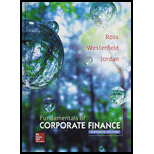
Fundamentals of Corporate Finance with Connect Access Card
11th Edition
ISBN: 9781259418952
Author: Stephen A. Ross Franco Modigliani Professor of Financial Economics Professor, Randolph W Westerfield Robert R. Dockson Deans Chair in Bus. Admin., Bradford D Jordan Professor
Publisher: McGraw-Hill Education
expand_more
expand_more
format_list_bulleted
Textbook Question
Chapter 16, Problem 13QP
Calculating WACC [LO1] Braxton Corp. has no debt but can borrow at 6.4 percent. The firm’s WACC is currently 10.2 percent, and the tax rate is 35 percent.
a. What is the company’s
b. If the firm converts to 25 percent debt, what will its cost of equity be?
c. If the firm converts to 50 percent debt, what will its cost of equity be?
d. What is the company’s WACC in part (b)? In part (c)?
Expert Solution & Answer
Want to see the full answer?
Check out a sample textbook solution
Students have asked these similar questions
What is the difference between a contra asset account and a liability?i need help.
What is the significance of a company’s price-to-earnings (P/E) ratio? i need answer.
What is the significance of a company’s price-to-earnings (P/E) ratio?
Chapter 16 Solutions
Fundamentals of Corporate Finance with Connect Access Card
Ch. 16.1 - Why should financial managers choose the capital...Ch. 16.1 - What is the relationship between the WACC and the...Ch. 16.1 - What is an optimal capital structure?Ch. 16.2 - Prob. 16.2ACQCh. 16.2 - Prob. 16.2BCQCh. 16.2 - Prob. 16.2CCQCh. 16.3 - What does MM Proposition I state?Ch. 16.3 - What are the three determinants of a firms cost of...Ch. 16.3 - Prob. 16.3CCQCh. 16.4 - What is the relationship between the value of an...
Ch. 16.4 - If we consider only the effect of taxes, what is...Ch. 16.5 - Prob. 16.5ACQCh. 16.5 - What are indirect bankruptcy costs?Ch. 16.6 - Can you describe the trade-off that defines the...Ch. 16.6 - What are the important factors in making capital...Ch. 16.7 - Prob. 16.7ACQCh. 16.7 - What is the difference between a marketed claim...Ch. 16.7 - What does the extended pie model say about the...Ch. 16.8 - Prob. 16.8ACQCh. 16.8 - Why might firms prefer not to issue new equity?Ch. 16.8 - Prob. 16.8CCQCh. 16.9 - Do U.S. corporations rely heavily on debt...Ch. 16.9 - What regularities do we observe in capital...Ch. 16.10 - Prob. 16.10ACQCh. 16.10 - Prob. 16.10BCQCh. 16 - Maximizing what will maximize shareholder value?Ch. 16 - What is most closely related to a firms use of...Ch. 16 - Give an example of a direct cost of bankruptcy.Ch. 16 - Prob. 16.7CTFCh. 16 - Prob. 1CRCTCh. 16 - Prob. 2CRCTCh. 16 - Optimal Capital Structure [LO1] Is there an easily...Ch. 16 - Observed Capital Structures [LO1] Refer to the...Ch. 16 - Financial Leverage [LO1] Why is the use of debt...Ch. 16 - Homemade Leverage [LO1] What is homemade leverage?Ch. 16 - Prob. 7CRCTCh. 16 - Prob. 8CRCTCh. 16 - Prob. 9CRCTCh. 16 - Prob. 10CRCTCh. 16 - Prob. 1QPCh. 16 - Prob. 2QPCh. 16 - Prob. 3QPCh. 16 - Prob. 4QPCh. 16 - MM and Stock Value [LO1] In Problem 4, use MM...Ch. 16 - Prob. 6QPCh. 16 - Prob. 7QPCh. 16 - Prob. 8QPCh. 16 - Homemade Leverage and WACC [LO1] ABC Co. and XYZ...Ch. 16 - Prob. 10QPCh. 16 - MM and Taxes [LO2] In the previous question,...Ch. 16 - Calculating WACC [LO1] Twice Shy Industries has a...Ch. 16 - Calculating WACC [LO1] Braxton Corp. has no debt...Ch. 16 - MM and Taxes [LO2] Meyer Co. expects its EBIT to...Ch. 16 - Prob. 15QPCh. 16 - MM [LO2] Tool Manufacturing has an expected EBIT...Ch. 16 - Prob. 17QPCh. 16 - Homemade Leverage [LO1] The Day Company and the...Ch. 16 - Weighted Average Cost of Capital [LO1] In a world...Ch. 16 - Cost of Equity and Leverage [LO1] Assuming a world...Ch. 16 - Business and Financial Risk [LO1] Assume a firms...Ch. 16 - Stockholder Risk [LO1] Suppose a firms business...Ch. 16 - Prob. 1MCh. 16 - Prob. 2MCh. 16 - Prob. 3MCh. 16 - Stephenson Real Estate Recapitalization Stephenson...Ch. 16 - Stephenson Real Estate Recapitalization Stephenson...
Knowledge Booster
Learn more about
Need a deep-dive on the concept behind this application? Look no further. Learn more about this topic, finance and related others by exploring similar questions and additional content below.Similar questions
arrow_back_ios
SEE MORE QUESTIONS
arrow_forward_ios
Recommended textbooks for you
 Intermediate Financial Management (MindTap Course...FinanceISBN:9781337395083Author:Eugene F. Brigham, Phillip R. DavesPublisher:Cengage Learning
Intermediate Financial Management (MindTap Course...FinanceISBN:9781337395083Author:Eugene F. Brigham, Phillip R. DavesPublisher:Cengage Learning EBK CONTEMPORARY FINANCIAL MANAGEMENTFinanceISBN:9781337514835Author:MOYERPublisher:CENGAGE LEARNING - CONSIGNMENT
EBK CONTEMPORARY FINANCIAL MANAGEMENTFinanceISBN:9781337514835Author:MOYERPublisher:CENGAGE LEARNING - CONSIGNMENT

Intermediate Financial Management (MindTap Course...
Finance
ISBN:9781337395083
Author:Eugene F. Brigham, Phillip R. Daves
Publisher:Cengage Learning

EBK CONTEMPORARY FINANCIAL MANAGEMENT
Finance
ISBN:9781337514835
Author:MOYER
Publisher:CENGAGE LEARNING - CONSIGNMENT

Financial leverage explained; Author: The Finance story teller;https://www.youtube.com/watch?v=GESzfA9odgE;License: Standard YouTube License, CC-BY